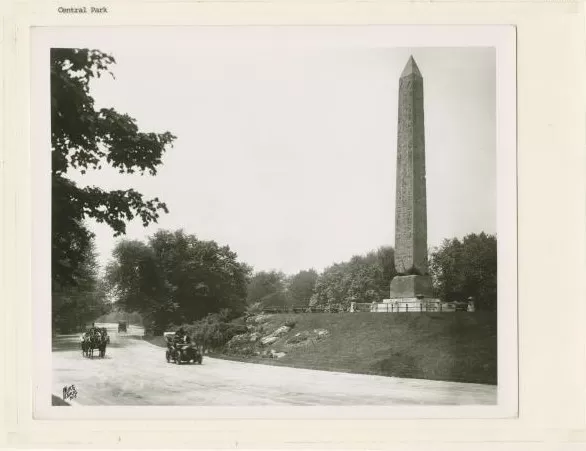
The obelisk, photographed not long after its arrival in New York. Image courtesy of the NYPL.
Atop Greywacke Knoll, within view of the Metropolitan Museum of Art, stands a monument of red granite. Inscribed upon it are hieroglyphs praising the life of Thutmosis III and the military victories of Ramesses II, events that transpired thousands of years and thousands of miles from modern day New York City. So how then has this ancient Egyptian obelisk, Cleopatra’s Needle, found itself standing tall in Central Park?
In our ten years of making games centered around NYC history, the story of the Central Park Obelisk has been one of GGC’s favorite monuments for its long and storied past, the various groups involved in its relocation, and its incongruity as an Egyptian obelisk in the middle of New York. We hope that shedding some light on this curious monument will get you interested not only in this piece of history, but in the many oddities that pepper the city’s streets.
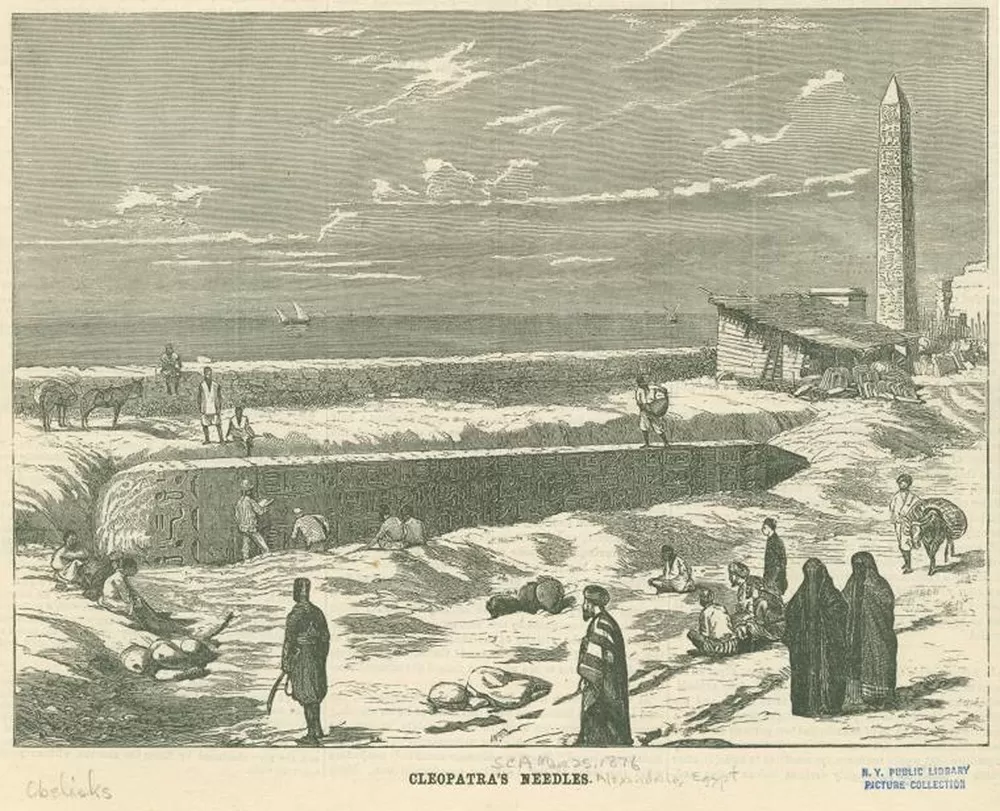
An engraving of both obelisks from 1876. Image courtesy of the NYPL.
The monument that graces the small hill in Central Park was originally one of a pair of obelisks commissioned by Pharaoh Thutmose III for the Temple of the Sun in Heliopolis in 1475 BCE. The two stood tall for centuries, a remarkable enough monument that Pharaoh Ramesses II (who had a habit of adding his own carvings to existing structures) deemed them worthy of being a testament to his military victories around 1275 BCE. Centuries more passed before the two were toppled during an attack on Heliopolis by the Achaemenid Empire in approximately 525 BCE, and then they spent centuries in the Egyptian sands, relatively well protected from the wind and sparse rain that might have weathered them.
It wasn’t until 12 BCE that the obelisks were raised again, this time a little over a hundred miles away in Alexandria. The two were erected in the Caesarium, a temple built by Queen Cleopatra to honor either Julius Caesar or Marc Antony (the historical record is unclear), and it was here that the duo got the name Cleopatra’s Needles. It was also here that the obelisks gained the decorative bronze crabs at their bases, one for each of the four corners, which were inscribed in Greek and Latin with a record of their placement.
For centuries again they stood tall, being described in traveler’s journals like those written by Abd al-Latif al-Baghdadi in the 13th century CE, until one of the pair toppled. The reason for its fall is unknown (though historian E.A.W. Budge speculated that the 1303 CE Crete earthquake was to blame), but what is known is that by the 17th century CE the needles were a well known sightseeing stop for Europeans visiting Egypt, and continued to be for as long as they still stood in their native land.
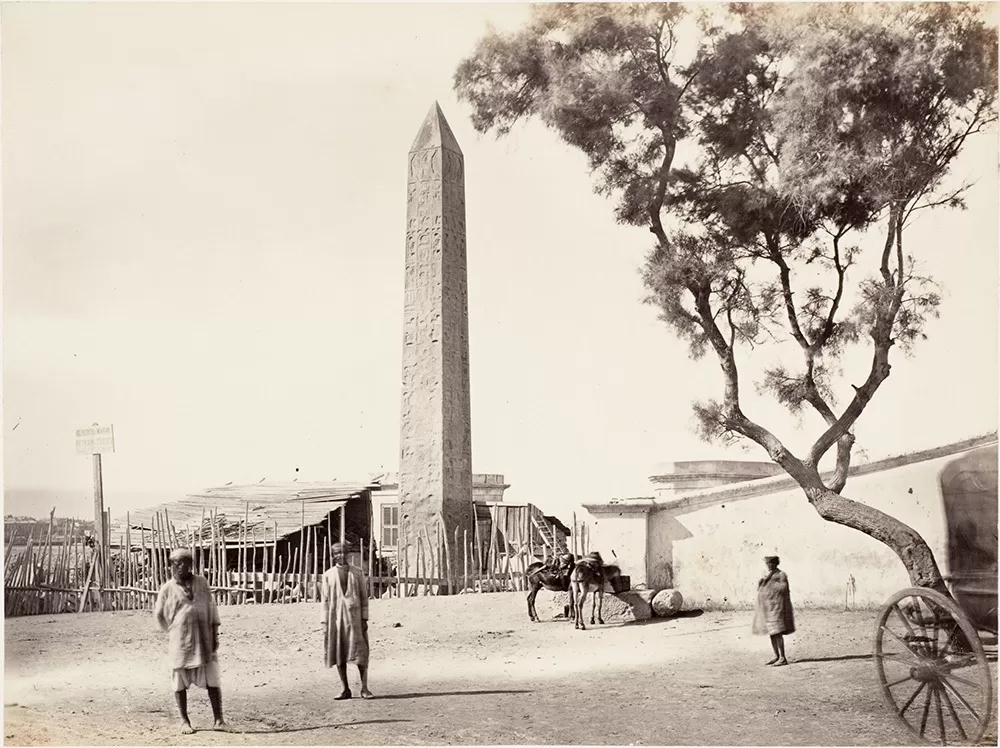
A photograph of New York's obelisk in Alexandria, circa 1870. Image courtesy of the Metropolitan Museum of Art.
Such was the case until the beginning of the 19th century. British presence was heavy in Egypt, especially its military presence, and in 1819 the de facto ruler of Egypt, Muhammad Ali Pasha, gifted the fallen obelisk to the British government in commemoration of the victories of Lord Nelson at the Battle of the Nile in 1798 and Ralph Abercromby at the Battle of Alexandria in 1801. Though the Brits accepted the gift, they declined to move it for a number of years due to the cost of transportation. It wasn’t until 1877 that the obelisk was moved to London and erected on the Victoria Embankment.
What spurred the move of the London obelisk almost 60 years after it was initially gifted was not a built up yearning for something promised long ago, but rather a fascination the British had that in the 1870’s had reached an all time high. Egyptomania had gripped the European elite, and all things Egypt were in vogue. Everyone wanted their own piece of the ancient civilization, and that included pillaged grave goods, hieroglyphs chipped off of monuments, and even powered mummies.
It was in this cultural climate that America, watching England claim its own obelisk, decided it wanted one too. In the same year that the first obelisk was transported to London, US consul-general in Egypt Elbert Farman began petitioning the Egyptian Khedive, Isma’il Pasha, to formally gift the second obelisk to the United States. Shortly thereafter the Commissioner of the Department of Public Parks of New York, Henry Stebbins, began to organize funding for the monument’s move. The petitioning efforts lasted over a year, during which time railroad magnate William Vanderbilt provided the majority of the funds needed, until the Egyptian government formally gifted the second of Cleopatra’s Needles to the US on May 18th, 1879.
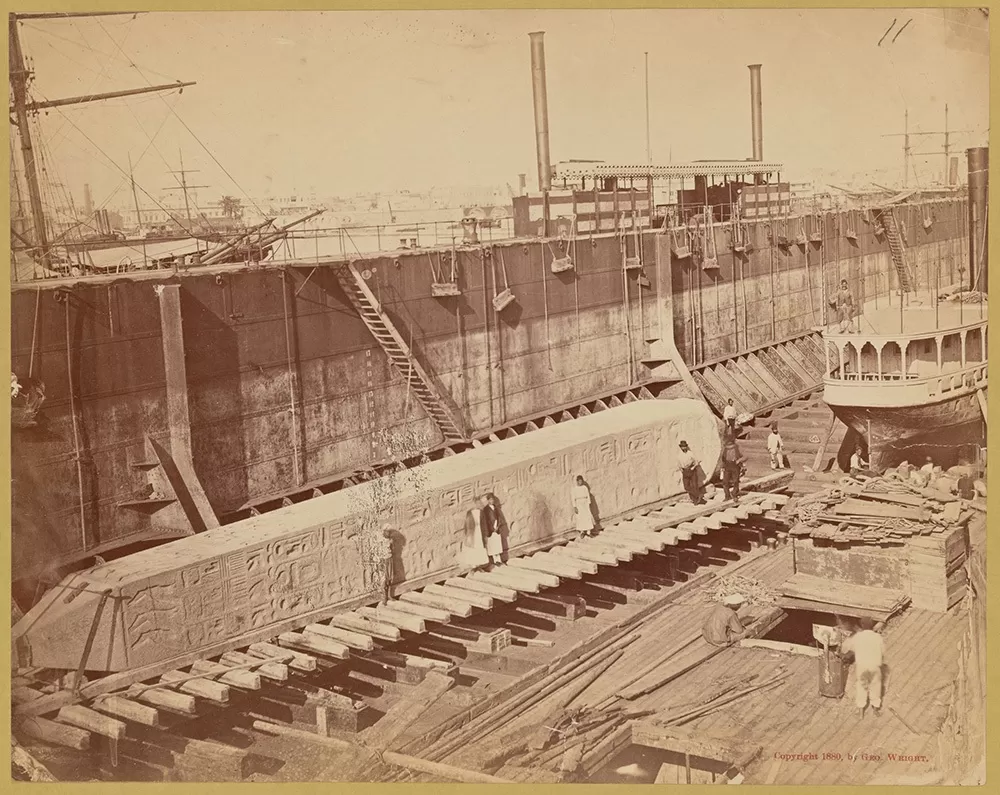
A photograph of the obelisk being loaded onto the Dessoug. Image courtesy of the NYPL.
The movement of the obelisk began in October of that year, to significant protests from Egyptian citizens. In the ensuing months since the obelisk’s transferal, Isma’il Pasha had (at the urgings of Britain and France) been deposed, and many hoped that the new Khedive, Tewfik Pasha, would retract the gift. But despite the wishes of the populace, task head Henry Gorringe ensured that the second of Cleopatra’s Needles was packed away on the SS Dessoug and set sail for America on June 12th, 1880.
A mere 38 days later, the Dessoug arrived in Staten Island, and the task of moving its cargo to Central Park began. First came the limestone pedestal, which was given a full Masonic cornerstone ceremony when it was placed on October 2nd, and then the granite masterpiece itself. As was the case when it was loaded in, a hole was cut into the bow of the ship so that it could be removed, and cannonballs were used to roll the ancient Egyptian obelisk onto land.
From there it took an agonizingly slow journey through the streets of New York City, being waylaid by blizzards and opportunists looking to chip away their own piece from the needle, until arriving at Greywacke Knoll on January 5th, 1881.
Finally, on January the 22nd, 1881, the second of Cleopatra’s Needles was erected in Central Park, anchored by four replica bronze crabs (two of the original crabs can be found in the Metropolitan Museum of Art) engraved with the history of the obelisk, and Central Park’s personal chunk of Egyptian history has remained a prominent sight ever since.
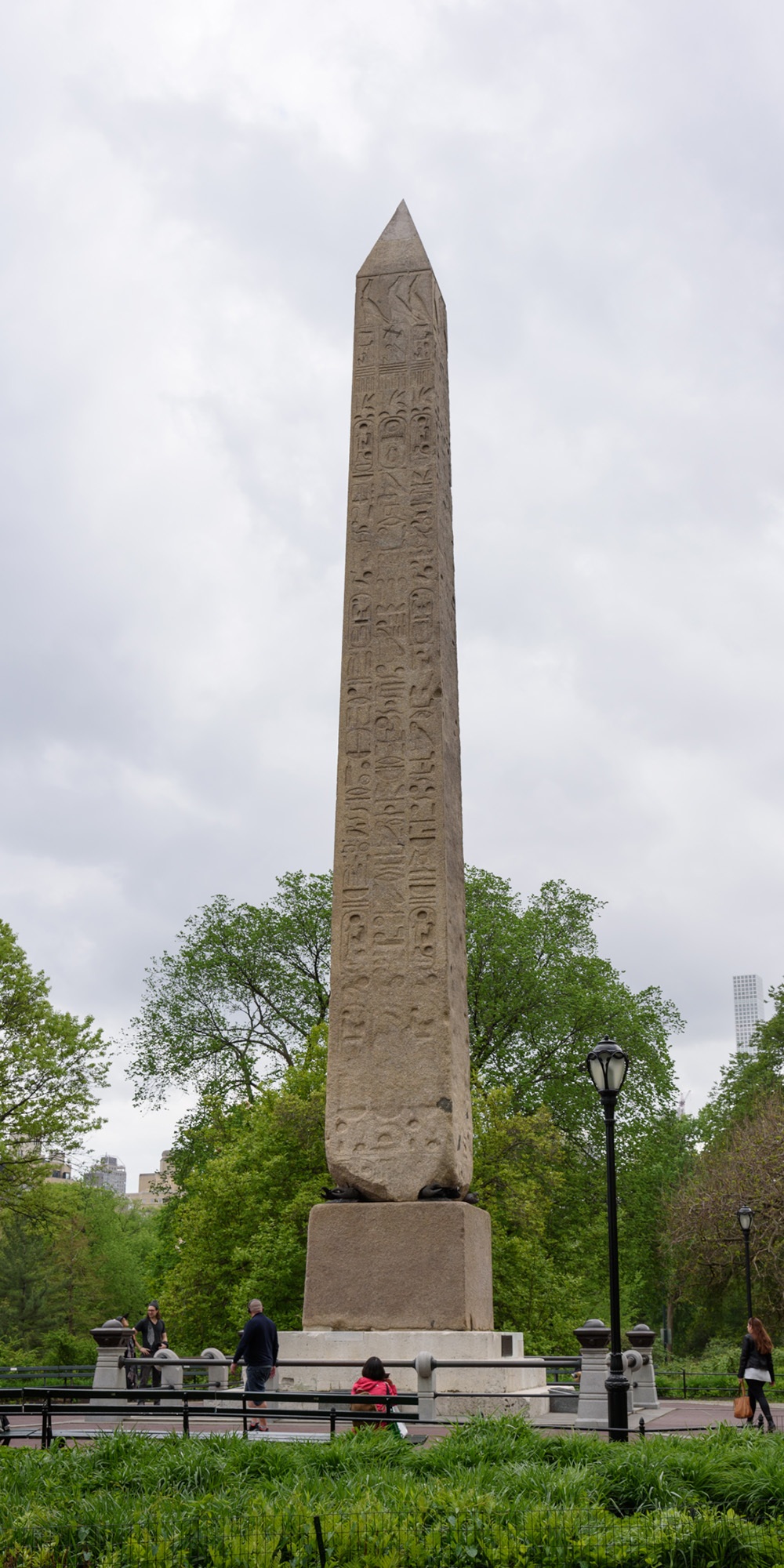
The obelisk, photographed in May of 2017. Image courtesy of King of Hearts CC BY-SA 4.0.
The weather and pollution of New York have taken a toll on the obelisk, designed for the desert as it was, and a number of efforts have been made over the years to protect the monument from weathering and erosion. The first of these, conducted in 1885, involved waterproofing the granite with creosote-laced paraffin wax, a process that ended up damaging the obelisk and its engravings more than the four years of NYC winters combined already had. Another effort in 1913 involved treating the stone with Tung oil, a substance which was known to be effective for waterproofing wood, but which washed right off the obelisk’s smooth sides. Most recently, conservation efforts by NYC Parks and the Met saw the monument cleaned with lasers, and fragile areas stabilized with adhesive compounds. But even with the most concerted efforts, the 143 years since the needle’s arrival in America have taken a greater toll on it than the three millennia it weathered in its homeland.
In 2010, Egyptian archaeologist Zahi Hawass sent an open letter to the Central Park Conservancy and Mayor Mike Bloomberg, promising that he would find a way to return the obelisk to Egypt if steps were not taken to improve conservation of the 3485 year old object. The letter, along with the increasing desire for restitution of antiques and artifacts back to their homelands, has had many wondering if Cleopatra’s Needle really belongs atop Greywacke Knoll. The journey it took to get here was long, and its residence in the park has been longer, but both are dwarfed by the centuries it spent in Heliopolis and Alexandria. Were a robber baron’s money and a politician's promise truly enough to buy one of the obelisks of Pharaoh Thutmosis III, or does the monument still belong to the people of Egypt? For now, the Central Park obelisk remains, but the future may yet see it brought home.
D'Alton, Martina. “The New York Obelisk, Or, How Cleopatra's Needle Came to New York and what Happened when it Got Here”. Metropolitan Museum of Art Bulletin, Spring 1993. Metropolitan Museum of Art/Abrams.
Hawass, Zahi. “Obelisk in Central Park”. drhawass.com. Archived from the original on November 9, 2014. Retrieved April 3, 2023.
Moldenke, Charles Edward. The New York Obelisk, Cleopatra's Needle: With a Preliminary Sketch of the History, Erection, Uses, and Signification of Obelisks. CRL-E-Resources. A. D. F. Randolph and Company.
Sain-Baird, Jessica. “How the Obelisk Made Its Home in Central Park”. The Official Website of Central Park NYC. February 1, 2018. Retrieved April 3, 2023.
1- Irma and Paul Milstein Division of United States History, Local History and Genealogy, The New York Public Library. "Central Park - Obelisk." The New York Public Library Digital Collections. 1887 - 1986. https://digitalcollections.nypl.org/items/510d47e2-1526-a3d9-e040-e00a18064a99
2- The Miriam and Ira D. Wallach Division of Art, Prints and Photographs: Picture Collection, The New York Public Library. "Cleopatra's needles" The New York Public Library Digital Collections. 1876-03-25. https://digitalcollections.nypl.org/items/510d47e4-6080-a3d9-e040-e00a18064a99
3- Frith, Francis (attributed). Egyptian Obelisk, “Cleopatra’s Needle” in Alexandria, Egypt. ca. 1870 albumen silver print from glass negative. Metropolitan Museum of Art, New York.
4- Irma and Paul Milstein Division of United States History, Local History and Genealogy, The New York Public Library. "The obelisk "Cleopatra's Needle," not yet crated, on ramp in dry dock prior to being loaded onto ship "Dessoug"" The New York Public Library Digital Collections. 1880. https://digitalcollections.nypl.org/items/b4313da0-a00b-0132-e861-58d385a7bbd0
5- King of Hearts, CC BY-SA 4.0 https://creativecommons.org/licenses/by-sa/4.0, via Wikimedia Commons
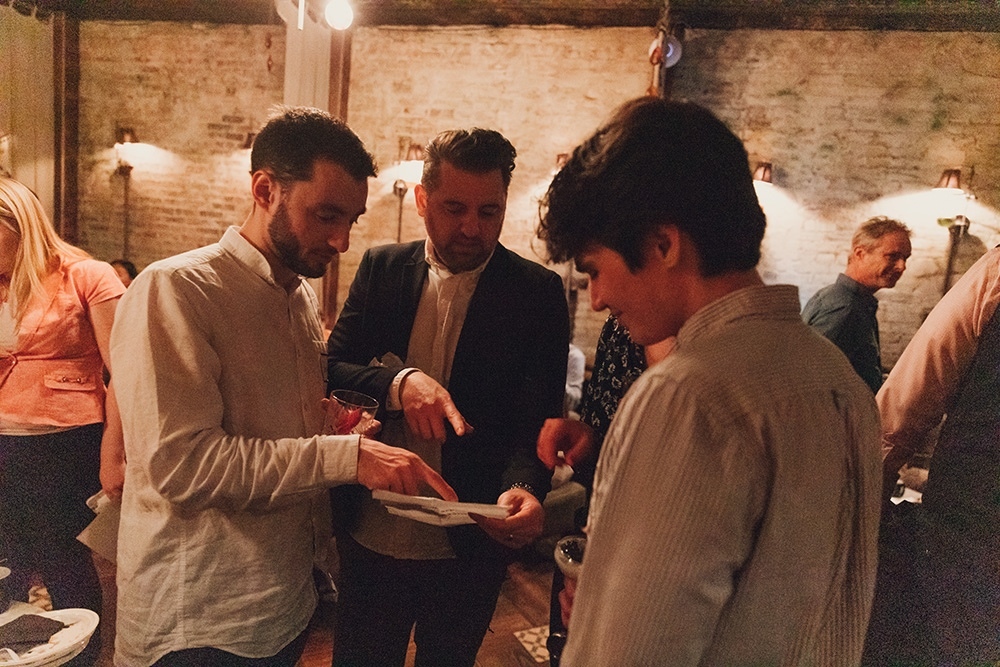
Great Gotham Challenge Recommends: Our Top 25 Favorite Team Building Activities- NYC
Team Building Activities
GGC Recommended Brain Strengthening Games For Intellectuals
Games For Smart People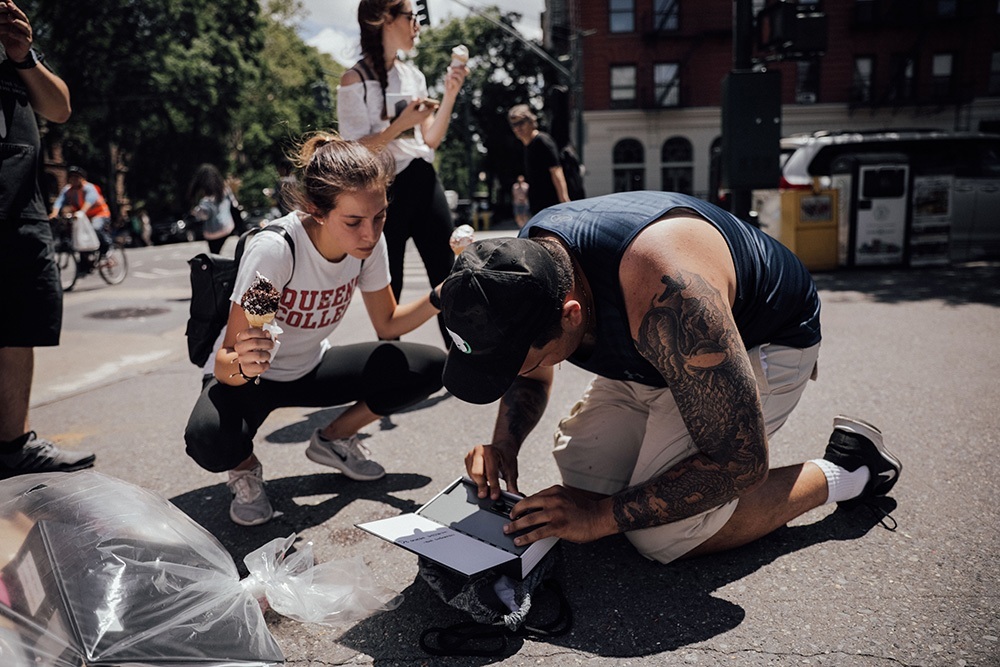

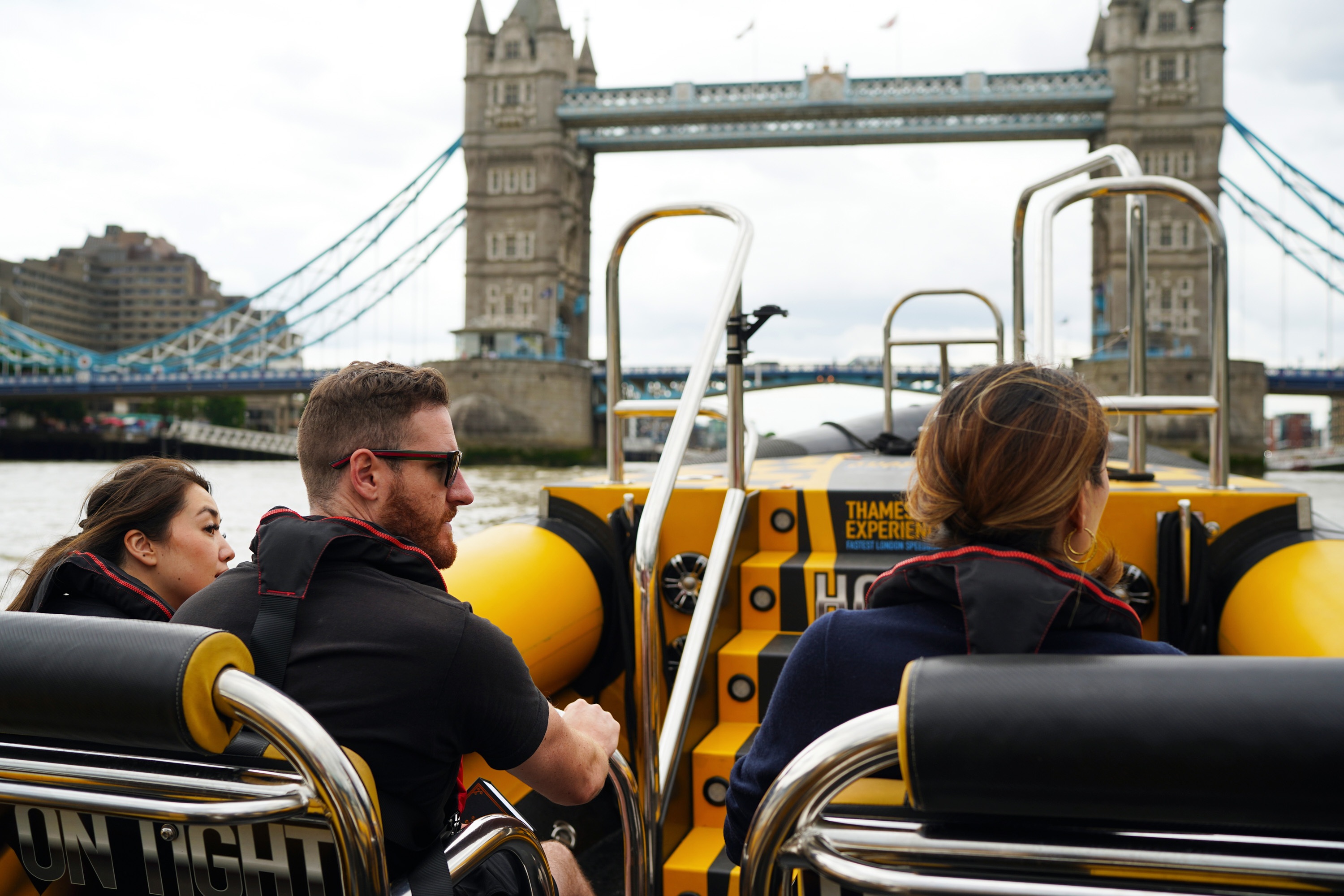
"We had high expectations and they were far exceeded. The challenges were difficult, extremely creative, and completely customized to our group. Suffice it to say our group couldn't have possibly had more fun. Thank you for making me look great!"
"I'm always very skeptical of these "team-building" events, but this one was over the top. They successfully handled our 120-person team, with puzzles that were really challenging. The whole experience couldn't have been more engaging!"
"One of our directors told me it was one of the best organized online challenges they've done."
"[The challenge] shattered any expectations I had. For a fully remote event, I expected a bit of cheesy fun, but the production quality is unbelievable. I absolutely recommend everyone to try it."
"To quote one of my teammates: "This [challenge] was mean and hard, and resultantly perfect." Thank you for the stellar experience, service, and fun."
"For a few hours, you get to feel like a secret agent as you traverse the mundane real world with a VIP pass for curated wonder."
"A mixture of live actors, custom puzzles, and clues built around pre-existing and famous structures in lends the event a sort of glam DaVinci Code energy."
To book our three most popular challenges for under 50 people:
Book InstantlyFor all other experiences or inquiries:
Get a quote






For advance notice on public events and special early bird discounts, please sign up for our communique below: